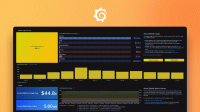Caution
Grafana Alloy is the new name for our distribution of the OTel collector. Grafana Agent has been deprecated and is in Long-Term Support (LTS) through October 31, 2025. Grafana Agent will reach an End-of-Life (EOL) on November 1, 2025. Read more about why we recommend migrating to Grafana Alloy.
Static mode
Static mode is the original mode of Grafana Agent. Static mode is composed of different subsystems:
The metrics subsystem wraps around Prometheus for collecting Prometheus metrics and forwarding them over the Prometheus
remote_writeprotocol.The logs subsystem wraps around Grafana Promtail for collecting logs and forwarding them to Grafana Loki.
The traces subsystem wraps around OpenTelemetry Collector for collecting traces and forwarding them to Grafana Tempo or any OpenTelemetry-compatible endpoint.
Static mode is configured with a YAML file.
Static mode works with:
- Grafana Cloud
- Grafana Enterprise Stack
- OSS deployments of Grafana Loki, Grafana Mimir, Grafana Tempo, and Prometheus
This topic helps you to think about what you’re trying to accomplish and how to use Grafana Agent to meet your goals.
You can set up and configure Grafana Agent in static mode manually, or you can follow the common workflows described in this topic.
Topics
Static mode Grafana Agent for Grafana Cloud integrations
There are different ways for you to set up Grafana Agent to scrape data—through Grafana’s integration platform or directly. Select a guide to get started:
Static mode Grafana Agent for Kubernetes Monitoring
Grafana Kubernetes Monitoring provides a simplified approach to monitoring your Kubernetes fleet by deploying Grafana Agent with useful defaults for collecting metrics. Select a guide to get started monitoring Kubernetes:
Use Grafana Agent directly to scrape telemetry data
Grafana Cloud integration workflows and the Kubernetes Monitoring solution are the easiest ways to get started collecting telemetry data, but sometimes you might want to use a manual approach to set your configuration options.
Use Grafana Agent to send logs to Grafana Loki
Logs are included when you set up a Cloud integration but you can take a more hands-on approach with the following guide.




